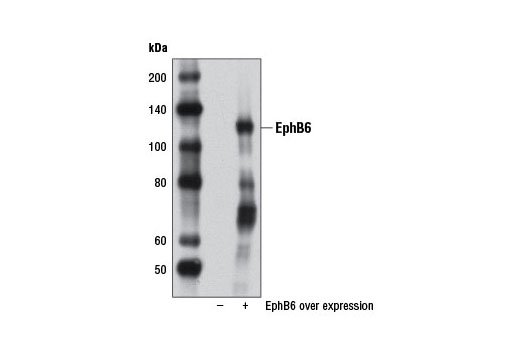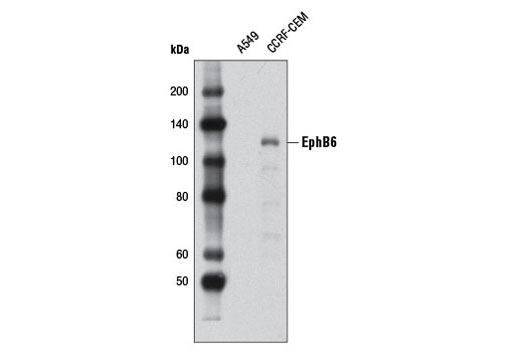WB, IP
H
Endogenous
125
Rabbit
#O15197
2051
Product Information
Product Usage Information
| Application | Dilution |
|---|---|
| Western Blotting | 1:1000 |
| Immunoprecipitation | 1:100 |
Storage
Specificity / Sensitivity
Species Reactivity:
Human
Source / Purification
Polyclonal antibodies are produced by immunizing animals with a synthetic peptide corresponding to residues surrounding Ala927 of human EphB6 protein. Antibodies are purified by protein A and peptide affinity chromatography.
Background
EphB6 is a kinase-defective receptor and member of the ephrin-B family of transmembrane proteins (1). Although lacking kinase activity, EphB6 can regulate cellular functions through its interaction with adaptor proteins and other Eph family members (2). In hematopoietic cells, EphB6 is specifically expressed in the T cell population (3) and functions as an important regulator of T cell receptor (TCR) mediated signaling. Upon binding with its ephrin-B1 or ephrin-B2 ligand, EphB6 modulates TCR activity through inhibition of JNK signaling, reduction of CD25 expression, and decreased IL-2 secretion (4). Reduced levels of cell proliferation and cytokine secretion are seen in EphB6 knock-out mice relative to wild type (5). In conjunction with EphB3 receptor activation, EphB6 suppresses Fas receptor induced apoptosis by triggering the Akt activation pathway (6). Research indicates that decreased EphB6 expression is associated with a higher degree of metastasis in various cancers, including breast cancer (7), lung cancer (8), and neuroblastoma (9). EphB6 is thought to reduce cancer invasiveness through its effect on cell adhesion and migration. Following EphrinB1 ligand binding, EphB6 is phosphorylated by kinases such as Src and another active EphB kinase (2, 10, 11). Phosphorylated EphB6 forms a stable complex with Cbl and initiates Cbl inhibition of cell adhesion (2,11). EphB6 regulates signal transduction through direct interaction with other active Eph receptor kinases, sequestering these EphB6-bound receptors and inhibiting typical signal transduction function (12).
- Gurniak, C.B. and Berg, L.J. (1996) Oncogene 13, 777-86.
- Freywald, A. et al. (2002) J Biol Chem 277, 3823-8.
- Shimoyama, M. et al. (2000) Growth Factors 18, 63-78.
- Freywald, A. et al. (2003) J Biol Chem 278, 10150-6.
- Luo, H. et al. (2004) J Clin Invest 114, 1762-73.
- Maddigan, A. et al. (2011) J Immunol 187, 5983-94.
- Fox, B.P. and Kandpal, R.P. (2006) Biochem Biophys Res Commun 340, 268-76.
- Müller-Tidow, C. et al. (2005) Cancer Res 65, 1778-82.
- Tang, X.X. et al. (2000) Proc Natl Acad Sci U S A 97, 10936-41.
- Matsuoka, H. et al. (2005) J Biol Chem 280, 29355-63.
- Truitt, L. et al. (2010) Cancer Res 70, 1141-53.
- Fox, B.P. and Kandpal, R.P. (2011) Cancer Genomics Proteomics 8, 185-93.
Species Reactivity
Species reactivity is determined by testing in at least one approved application (e.g., western blot).
Western Blot Buffer
IMPORTANT: For western blots, incubate membrane with diluted primary antibody in 5% w/v BSA, 1X TBS, 0.1% Tween® 20 at 4°C with gentle shaking, overnight.
Applications Key
WB: Western Blotting IP: Immunoprecipitation
Cross-Reactivity Key
H: human M: mouse R: rat Hm: hamster Mk: monkey Vir: virus Mi: mink C: chicken Dm: D. melanogaster X: Xenopus Z: zebrafish B: bovine Dg: dog Pg: pig Sc: S. cerevisiae Ce: C. elegans Hr: horse GP: Guinea Pig Rab: rabbit All: all species expected
Trademarks and Patents
Limited Uses
Except as otherwise expressly agreed in a writing signed by a legally authorized representative of CST, the following terms apply to Products provided by CST, its affiliates or its distributors. Any Customer's terms and conditions that are in addition to, or different from, those contained herein, unless separately accepted in writing by a legally authorized representative of CST, are rejected and are of no force or effect.
Products are labeled with For Research Use Only or a similar labeling statement and have not been approved, cleared, or licensed by the FDA or other regulatory foreign or domestic entity, for any purpose. Customer shall not use any Product for any diagnostic or therapeutic purpose, or otherwise in any manner that conflicts with its labeling statement. Products sold or licensed by CST are provided for Customer as the end-user and solely for research and development uses. Any use of Product for diagnostic, prophylactic or therapeutic purposes, or any purchase of Product for resale (alone or as a component) or other commercial purpose, requires a separate license from CST. Customer shall (a) not sell, license, loan, donate or otherwise transfer or make available any Product to any third party, whether alone or in combination with other materials, or use the Products to manufacture any commercial products, (b) not copy, modify, reverse engineer, decompile, disassemble or otherwise attempt to discover the underlying structure or technology of the Products, or use the Products for the purpose of developing any products or services that would compete with CST products or services, (c) not alter or remove from the Products any trademarks, trade names, logos, patent or copyright notices or markings, (d) use the Products solely in accordance with CST Product Terms of Sale and any applicable documentation, and (e) comply with any license, terms of service or similar agreement with respect to any third party products or services used by Customer in connection with the Products.


